| Colliding-wind binaries |
| WR140 radio variation |
| Episodic dust-makers |
| WR140 orbital motion |
| Massive Stars Web site |
| All about Wolf-Rayet Stars: 2015 Potsdam workshop |
| 2009 Campaign results |
| Co-ordinates J2000 |
| R.A. 20 20 27.98 Dec. +43 51 16.3 |
WR 140 (= HD 193793 = BD +43° 3571 = V1687 Cyg) is a massive binary system comprising a WC7 type Wolf-Rayet star and an O5 star, probably a supergiant. Both stars have fast (3000 km/s), radiatively driven, stellar winds carrying significant mass loss, about 10-5 and 10-6 solar masses/year (WC7 and O5 stars respectively), and therefore having significant kinetic power (mechanical luminosity), equivalent to 104 and 103 Solar luminosities. Between the two stars, the winds collide, releasing some of this power (about 103 solar luminosities) and producing shocks, resulting in particle acceleration and heating and compression of the plasma in the shocked winds. The consequences of these colliding-wind processes are observed at X-ray and radio wavelengths, making WR140 one of the brightest non-compact stellar X-ray sources [1] and a non-thermal radio source [2]. Variations of the X-ray and radio emission are observed as the stars move in their eccentric binary orbit [3]. High-resolution imaging of the stars themselves has provided an astrometric orbit [6] , completing the definition of the orbit in three dimensions.
WR140 was also the first Wolf-Rayet star to show a sudden brightening in its
infrared flux, attributed to an episode of dust formation [4].
This dust (a form of carbon, rather like soot)
condenses in the stellar wind, absorbing a small fraction of the stars'
UV-optical radiation. This radiation heats the dust to a temperature
of about 1000K, causing the brightening at infrared wavelengths.
The newly formed dust is dispersed by the stellar wind and cools as it
is carried further from the stars and experiences less heating by their
radiation, causing its infrared emission to fade. A second episode of dust
formation by WR140 was observed in 1985, and it was argued that these events
were periodic and also linked to a binary orbit, occurring
near the time of periastron passage [3].
Similar episodes were observed in 1993, 2001 and 2009 [8],
having a period near 2897 days, equal to that of the binary orbit.
WR140 is the prototype periodic episodic dust-maker.
The dust cloud formed in the 2001 episode has been imaged at high resolution in the
infrared: in mid-2001 with aperture-masking on the Keck telescope by Monnier et
al. [5], then with near-IR cameras and adaptive optics systems on
the Hale and William Herschel telescopes, and then at wavelengths between 3.6 and 10
µm with UKIRT and Gemini (North) as the cloud expanded and cooled [7].
Some of the 4-µm images are shown below.
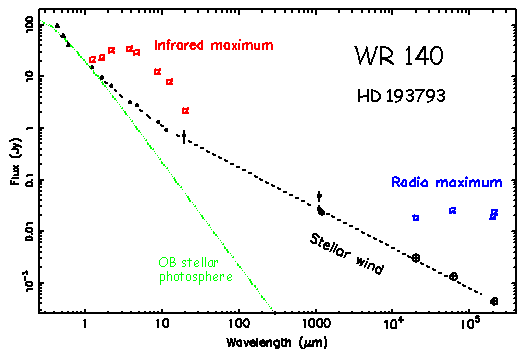
Right: K-band "light curves" near the 1977, 1985, 1993, 2001 and 2009 maxima from data in [3], [4], [7] and [8], phased to the orbit.
Far right: Infrared (4 µm) image of WR 140 observed in November 2002, (phase 0.23) showing dust emission south and east of the star (scale 4 x 4 arcseconds).
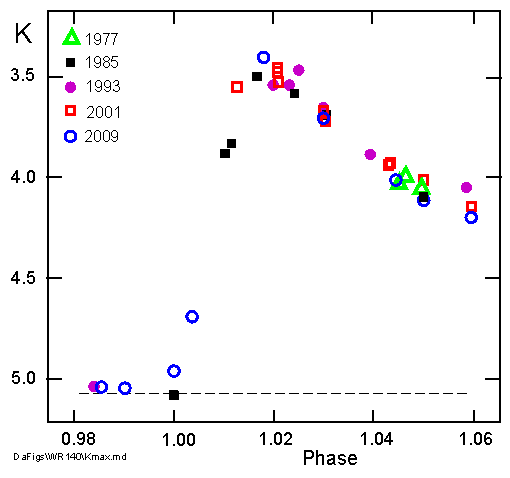
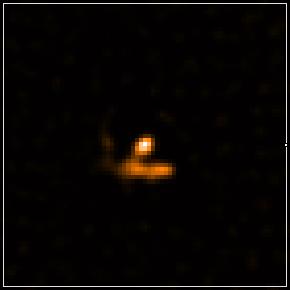
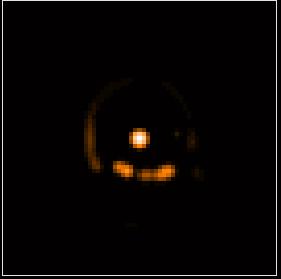
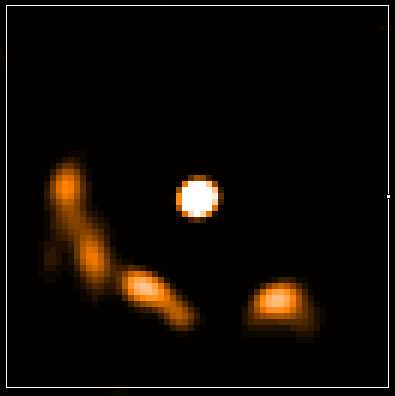
The most recent periastron passage occurred in 2016, and stimulated an intensive multi-wavelength observing campaign. Results from the 2009 periastron campaign were reported at two meetings in 2010: Stellar Winds in Interaction" and the 39th Liège International Astrophysical Colloquium "The multi-wavelength view of Hot Massive Stars" including 2009 Campaign results.
WR 140 has been observed by most X-ray missions. Recent results from SUZAKU reported by Suguwara et al. show that there is still a great deal about the system and colliding wind physics that we do not understand.
Critical configurations of WR 140 in 2016-17 and 2024-25
| phase | MJD | Year | Date | Orbital phenomenon | f | r/a | P.A. | pos | ψ | MJD | Year | Date |
| 0.9551 | 57610 | 2016.62 | Aug 10 | conjunction: WC star behind | 223 | 0.56 | 84 | E | 30 | 60506 | 2024.54 | July 15 |
| 0.9965 | 57730 | 2016.94 | Dec 8 | quadrature | 313 | 0.12 | 354 | N | 90 | 60626 | 2024.86 | Nov 12 |
| 0.000 | 57740 | 2016.96 | Dec 18 | periastron passage | 0 | 0.10 | 327 | NW | 129 | 60637 | 2024.89 | Nov 23 |
| 0.0032 | 57749 | 2016.99 | Dec 27 | conjunction: O star behind | 42 | 0.12 | 263 | W | 150 | 60645 | 2024.91 | Dec 1 |
| 0.0393 | 57855 | 2017.28 | April 11 | quadrature | 133 | 0.51 | 174 | S | 90 | 60751 | 2025.21 | Mar 17 |
Peredur Williams
[Home page]
[2] R.H. Becker & R.L. White ApJ 297, 649, 1985
[3] P.M. Williams et al. MNRAS 243, 662, 1990
[4] P.M. Williams et al. MNRAS 185, 467, 1978
[5] J.D. Monnier, P.G. Tuthill & W.C. Danchi ApJ 567, L137, 2002
[6] J.D. Monnier et al. ApJL 742, 1, 2011
[7] P.M. Williams et al. MNRAS 395, 1749, 2009
[8] O.G. Taranova & V.I. Shenavrin Astronomy Letters, 37, 30, 2011
[9] Y. Suguwara et al. PASJ, 67, 121, 2015